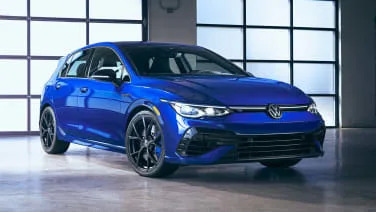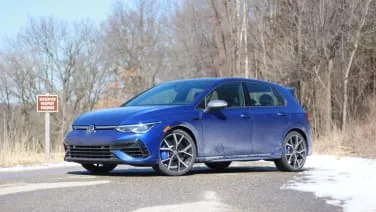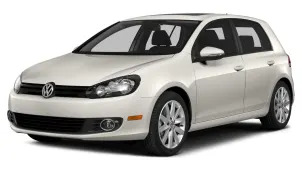2.5L 4dr Front-Wheel Drive Hatchback
2014 Volkswagen Golf
This Little VW Just Went Premium The fortunes of Volkswagen in the United States are moving steadily upward in direct correlation to how serious Wolfsburg has become about our market, a market it frankly neglected badly for about three full decades. The era of neglect is over now and the Germans are focusing especially hard on North American drivers who may have never owned a VW. For many in the US, a first Volkswagen will be either a Jetta or Passat, both of which have pretty good trunks. But we just drove this all-new seventh generation Golf and it needs to be on that same consideration list because it is a nearly perfect, sensibly sized trunkless car. The numbers for the Golf since its invention in 1974 are staggering. By the start of 2013, the Golf (called Rabbit for many of those bleakest years here in the States) will have sold nearly 30 million units worldwide. The Golf Mk VI, which is still offered in many markets including the US, remains the dominant best-selling car in all of Europe at the end of its life cycle. VW didn't really need to update much to keep the sales ball rolling. But this Golf VII, introduced in September at the Paris Motor Show, is an all-new car, even though from the outside things look strictly evolutionary. The chief ingredient in making true this claim of being "all-new" is the use of a completely reworked architecture called MQB, which stands for Modularer Querbaukasten, or "modular transverse matrix." New architectures for any company signify shockingly massive investments, and therefore the damned things had better be really good for the bottom line. In the case of MQB, company leaders estimate the price tag for its four years of development totals $65 billion, so the intent is that MQB will stick around for at least a decade before a replacement architecture is even talked about. The Golf VII is an all-new car, even though from the outside things look strictly evolutionary. Making certain it earns its keep quickly, VW Group has announced that MQB will be used on everything with transverse engines coming from VW, Audi, Seat and Škoda, ranging from models the size of the next VW Polo on up to the next Passat – that is to say, a major percentage of all cars produced within VW Group. So far, we've driven MQB with the new Audi A3, and now here with the four-door Golf Mk VII. For this event, we picked the upgraded 146-horsepower 2.0 TDI Golf in its top European Highline trim using an optional six-speed DSG dual-clutch automatic with shift paddles. At this launch event, the TDI motor we chose was available alongside a revamped 138-hp 1.4 TSI gas engine with Active Cylinder Technology, but the latter is not on call for US deliveries, so we took the global diesel route. The current second engine to be used in North America is the recently re-engineered 1.8 TFSI four-cylinder with 158 hp, …
Full Review
This Little VW Just Went Premium The fortunes of Volkswagen in the United States are moving steadily upward in direct correlation to how serious Wolfsburg has become about our market, a market it frankly neglected badly for about three full decades. The era of neglect is over now and the Germans are focusing especially hard on North American drivers who may have never owned a VW. For many in the US, a first Volkswagen will be either a Jetta or Passat, both of which have pretty good trunks. But we just drove this all-new seventh generation Golf and it needs to be on that same consideration list because it is a nearly perfect, sensibly sized trunkless car. The numbers for the Golf since its invention in 1974 are staggering. By the start of 2013, the Golf (called Rabbit for many of those bleakest years here in the States) will have sold nearly 30 million units worldwide. The Golf Mk VI, which is still offered in many markets including the US, remains the dominant best-selling car in all of Europe at the end of its life cycle. VW didn't really need to update much to keep the sales ball rolling. But this Golf VII, introduced in September at the Paris Motor Show, is an all-new car, even though from the outside things look strictly evolutionary. The chief ingredient in making true this claim of being "all-new" is the use of a completely reworked architecture called MQB, which stands for Modularer Querbaukasten, or "modular transverse matrix." New architectures for any company signify shockingly massive investments, and therefore the damned things had better be really good for the bottom line. In the case of MQB, company leaders estimate the price tag for its four years of development totals $65 billion, so the intent is that MQB will stick around for at least a decade before a replacement architecture is even talked about. The Golf VII is an all-new car, even though from the outside things look strictly evolutionary. Making certain it earns its keep quickly, VW Group has announced that MQB will be used on everything with transverse engines coming from VW, Audi, Seat and Škoda, ranging from models the size of the next VW Polo on up to the next Passat – that is to say, a major percentage of all cars produced within VW Group. So far, we've driven MQB with the new Audi A3, and now here with the four-door Golf Mk VII. For this event, we picked the upgraded 146-horsepower 2.0 TDI Golf in its top European Highline trim using an optional six-speed DSG dual-clutch automatic with shift paddles. At this launch event, the TDI motor we chose was available alongside a revamped 138-hp 1.4 TSI gas engine with Active Cylinder Technology, but the latter is not on call for US deliveries, so we took the global diesel route. The current second engine to be used in North America is the recently re-engineered 1.8 TFSI four-cylinder with 158 hp, …
Hide Full Review
Hide Full Review
Retail Price
$19,995
MSRP / Window Sticker Price
| Engine | 2.5L I-5 |
| MPG | 23 City / 30 Hwy |
| Seating | 5 Passengers |
| Transmission | 6-spd w/OD |
| Power | 170 @ 5700 rpm |
| Drivetrain | front-wheel |
Smart Buy Program is powered by 





